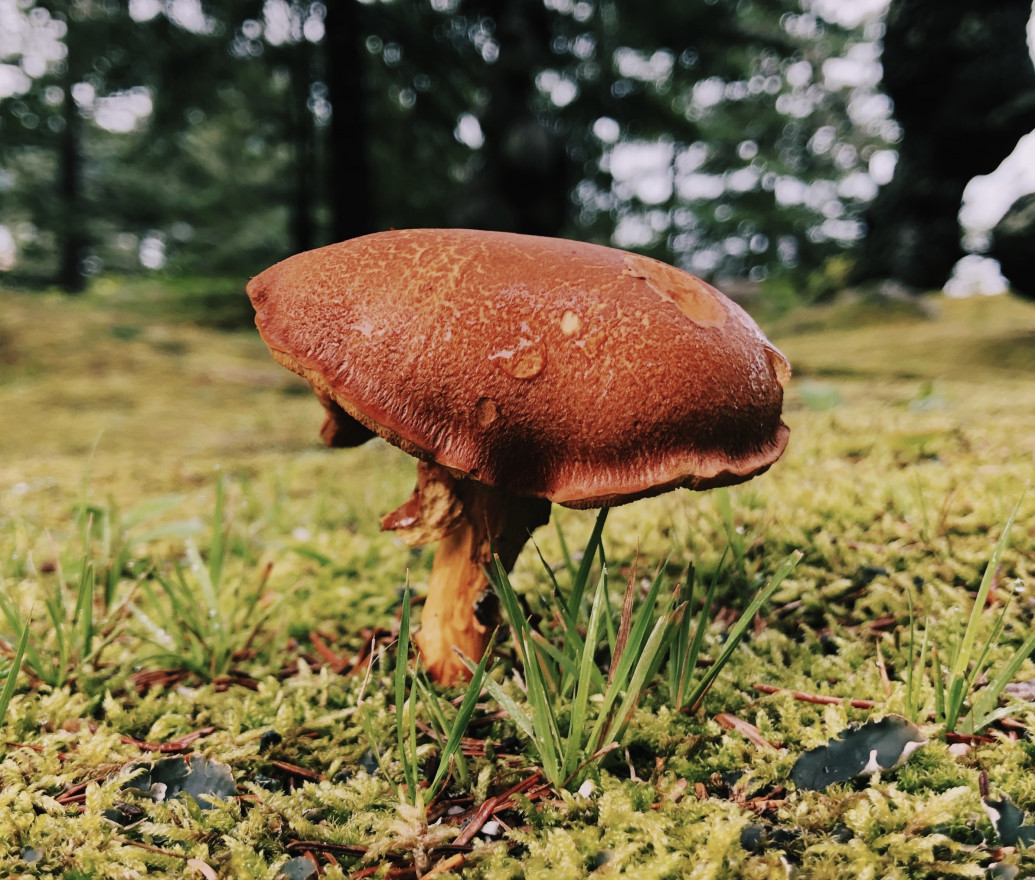
A mushroom cap in Mount Desert Island, Maine (Michaela Compo/George Washington University)

A mushroom cap in Mount Desert Island, Maine (Michaela Compo/George Washington University)
Only the very top centimeter of the cap was visible poking up from behind the dark wooden trim. Slowly, over the course of the night, a pale brown fungus reached towards the warmth of the pottery studio. There, inside the house, was a mushroom who had found a new home for the fall in chilly Vermont.
Courtesy of extensive, amateur Google searches, the mushroom is presumably Coprinopsis atramantaria, commonly known as an ink cap mushroom –– or not, I am truly no expert. Regardless, being quarantined in the suburbs of Burlington has provided a window into the vast network of neighbors I had never thought to look for, especially not in my own home. Stemming from this same sense of wonder, with significantly more precision and expertise, is the field of mycology: the study of fungi.
In an attempt to further understand my fungal neighbors I turned to the experts in mycology for answers. Why were they growing inside my studio? Could mushrooms adapt to human-influenced conditions? What would their adaptability do to benefit the broader environment in the age of climate change? As it turns out, another group of neighbors, humans this time, released a paper in recent years through the Gund Institute for Environment at the University of Vermont in an attempt to tackle some of these questions.
Perhaps it would be helpful to briefly introduce the terminology used in the following exploration. The mycellium is a web of thread-like hyphae (vegetative filaments) that stem from each individual mushroom and connect them to each other beneath the earth. Researchers Alison Bennett and Aimee Classen hypothesized about the impact of climate change on fungi characterized by these mycelium. Their study of experimental warming and precipitation variability examined the impact these stressors have on fungi.
Amidst a staring contest with my new fungal housemate, I reflected upon the weather patterns in our area for the past couple weeks. It seems as though the rain on Monday, warmth on Tuesday and ongoing spells of variable weather might have had some sort of impact on the growth of mushrooms in the area. As it turns out, these ink cap mushrooms are common in yards and other grassy areas. With the knowledge that it is not uncommon to have these fungi sprout up near homes, there remains a question of why these areas and what does weather have to do with it?
Bennett and Classen discuss these growth patterns, or hyphal exploration types, and the diversity of ability they provide to fungi. Much of where mushrooms end up growing depends on their exploration and deposition of spores.
I imagine the miniscule hyphae pushing themselves and the rest of their body in between the sheetrock and floorboards, searching for moist, warm air.
By gathering and sifting through literature to form connections between climate change, fungi and plant growth, the scientists found that fungi seem to act in a new role: a buffer.
Through the underground mycelial network, plants and some fungi exist symbiotically, and these fungi are called mycorrhizal fungi. This relationship is characterized by a constant exchange of water and nutrients from the fungi to the plant and photosynthetic sugars from the plant to the fungi. Bennett and Classen conclude that these fungi could perhaps, “…buffer plant hosts against extinction risk, they can facilitate or retard the dispersal success of plants moving away from poor environments, and, by buffering host plants, they can enable host plant adaptation to new climates.” Fungi, it seems, are perhaps the key to protecting the green of Earth’s future.
Using their hyphae, mycorrhizal fungi are able to increase surface area, promoting increased water absorption. This provides a sort of reservoir for their plant partners to draw from in cases of low water availability in soil. As the Anthropocene continues, precipitation patterns are becoming increasingly irregular and unpredictable. By having this safety net of a mycelial network backing them up, Bennet and Classen hope that the future impacts of climate change will be at least partially mitigated by the ability for these mycorrhizal fungi to adapt to changing conditions.
A sense of comfort is offered through this exploration of the symbiotic relationship between fungi and plants in the age of climate change. It is reassuring to know that the ink caps’ connections through the mycelial network of millions of fungi are taking care of the plant-life, at least until humans hopefully figure out how to show them as much respect.
The next step in this journey is to make pottery glazes from these ink cap mushrooms, but that will be an experiment for another day.